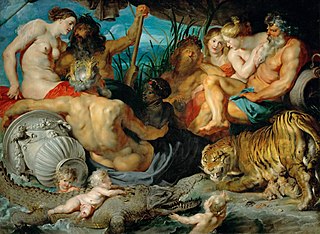 W
WAir is a painting created by Flemish painter Jan van Kessel (1626–1679) and was painted around the year 1647. It is a part of the permanent collection at the Flint Institute of Arts.
 W
WAllegory of the Vanities of the World is a 1663 painting by the Flemish painter Pieter Boel, now in the Palais des Beaux-Arts de Lille. It is unusually large for a vanitas painting.
 W
WThe Five Senses are a pair of oil paintings made by Jan Brueghel the Elder and others in 1617–18, at the same time as he was working with Peter Paul Rubens on a series of five paintings on the same topic. The originals were lost in a fire in 1731; faithful copies dated to c. 1620 were preserved and are in the Prado Museum in Madrid.
 W
WThe Five Senses is a set of allegorical paintings created at Antwerp in 1617–18 by Jan Brueghel the Elder and Peter Paul Rubens, with Brueghel being responsible for the settings and Rubens for the figures. They are now in the Prado Museum in Madrid. They are all painted in oils on wood panel, approximately 65 by 110 centimetres in dimensions.
 W
WThe Four Continents, also known as The Four Rivers of Paradise, is a painting by Flemish artist Peter Paul Rubens, made in the 1610s. It depicts the female personifications of, what, at the time, were believed to be four continents sitting with the personifications of their respective major rivers – the Danube, the Ganges, the Nile and the Río de la Plata. Europe is shown on the left, Africa in the middle, Asia on the right and America behind it, to the left. The tigress, protecting the cubs from the crocodile, is used as a symbol of Asia. The personification of the Danube holds a rudder. The bottom part of the painting shows several putti. Painted during a period of truce between the Dutch Republic and Spain, the river allegories and their female companions in a lush, bountiful setting reflect the conditions that Rubens hoped would return to Antwerp after military hostilities.
 W
WSir John Luttrell is an allegorical portrait in oils by the London-based Flemish artist Hans Eworth painted in 1550, of Sir Sir John Luttrell, an English soldier, diplomat, and courtier under Henry VIII and Edward VI.
 W
WThe Marie de' Medici Cycle is a series of twenty-four paintings by Peter Paul Rubens commissioned by Marie de' Medici, widow of Henry IV of France, for the Luxembourg Palace in Paris. Rubens received the commission in the autumn of 1621. After negotiating the terms of the contract in early 1622, the project was to be completed within two years, coinciding with the marriage of Marie's daughter, Henrietta Maria. Twenty-one of the paintings depict Marie's own struggles and triumphs in life. The remaining three are portraits of herself and her parents. The paintings now hang in the Louvre in Paris.
 W
WThe Signs of the Zodiac is a series of twelve allegorical paintings of the signs of the Zodiac, originally painted around 1640 by Jacob Jordaens and bought by the French Senate in 1802 for the ceiling of the east gallery of the Palais du Luxembourg in Paris, then occupied by the Musée du Luxembourg and now housing a library annexe.
 W
WTriumph of Frederick Henry, Prince of Orange is a painting by Jacob Jordaens, signed and dated at the bottom left "J JOR fec / 1652".
 W
WThe Union of Earth and Water is a Baroque painting by Flemish artist Peter Paul Rubens, showing Cybele as the personification of earth holding the horn of plenty and Neptune as the personification of water in the center. The pair is crowned by the goddess Victoria and the union is heralded through a conch by the Triton below. The union symbolizes fertility, wealth and prosperity, specifically the city of Antwerp and the river Scheldt whose mouth in Rubens' times was blocked by the Dutch depriving Flanders of the access to the sea. The painting features a pyramidal composition, symmetry and the balance of forms. It was influenced by late Italian Renaissance, particularly by Venetian artists.